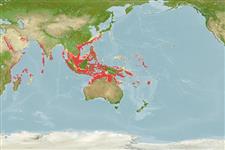Klassifizierung / Names
Namen | Synonyme | Catalog of Fishes (gen., sp.) | ITIS | CoL | WoRMS | Cloffa
Actinopterygii (Strahlenflosser) >
Perciformes (Perch-likes) >
Serranidae (Sea basses: groupers and fairy basslets) > Epinephelinae
Etymology: Plectropomus: Greek,plektron = anything to strike with, spur + Greek, poma = cover, operculum (Ref. 45335).
Lebensraum / Klimazone / Range
Ökologie
; seewasser riff-verbunden; tiefenbereich 25 - 147 m (Ref. 5222). Tropical, preferred 28°C (Ref. 107945); 33°N - 19°S, 32°E - 180°E (Ref. 5222)
Indo-Pacific: Red Sea, Zanzibar, Maldives, St. Brandon's Shoals, Sri Lanka, Chagos, Nazareth Bank, Sumatra, and Fiji. Recently recorded from Tonga (Ref. 53797). Subspecies, Plectropomus pessuliferus marisburi occurs in the Red Sea, while Plectropomus pessuliferus pessuliferus from the rest of the Indo-Pacific region (Ref. 3150). Often misidentified as Plectropomus maculatus.
Length at first maturity / Size / Gewicht / Alter
Maturity: Lm ?, range 63 - ? cm
Max length : 120 cm TL Männchen/unbestimmt; (Ref. 5222)
Rückenflossenstacheln (insgesamt): 7 - 8; Rückenflossenweichstrahlen (insgesamt): 10-12; Afterflossenstacheln 3; Afterflossenweichstrahlen: 8.
An uncommon species (Ref. 9710) found in shallow lagoon and seaward reefs. In the Hong Kong live fish markets (Ref. 27253). Solitary (Ref 90102).
Life cycle and mating behavior
Geschlechtsreife | Fortpflanzung | Ablaichen | Eier | Fecundity | Larven
Heemstra, P.C. and J.E. Randall, 1993. FAO Species Catalogue. Vol. 16. Groupers of the world (family Serranidae, subfamily Epinephelinae). An annotated and illustrated catalogue of the grouper, rockcod, hind, coral grouper and lyretail species known to date. Rome: FAO. FAO Fish. Synop. 125(16):382 p. (Ref. 5222)
IUCN Rote Liste Status (Ref. 115185)
CITES (Ref. 94142)
Not Evaluated
Bedrohung für Menschen
Harmless
Nutzung durch Menschen
Fischereien: kommerziell; Sportfisch: ja
Mehr Information
ReferenzenAquakulturAquakultur ProfilZuchtlinienGenetikAllel-HäufigkeitenVererbbarkeitKrankheitenVerarbeitungMass conversion
PartnerBilderStamps, CoinsLauteCiguateraGeschwindigkeitSchwimmstilKiemenoberflächeOtolithsGehirngrößeSehfähigkeit
Tools
Zusatzinformationen
Download XML
Internet Quellen
Estimates of some properties based on models
Phylogenetic diversity index (Ref.
82805): PD
50 = 0.5078 [Uniqueness, from 0.5 = low to 2.0 = high].
Bayesian length-weight: a=0.01122 (0.00543 - 0.02320), b=3.05 (2.88 - 3.22), in cm Total Length, based on LWR estimates for this (Sub)family-body shape (Ref.
93245).
Trophic Level (Ref.
69278): 4.2 ±0.7 se; Based on size and trophs of closest relatives
Widerstandsfähigkeit (Ref.
69278): sehr niedrig, Verdopplung der Population dauert mehr als 14 Jahre. (Preliminary K or Fecundity.).
Verwundbarkeit (Ref.
59153): High to very high vulnerability (71 of 100) .
